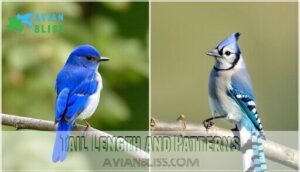This site is supported by our readers. We may earn a commission, at no cost to you, if you purchase through links.

Eastern bluebirds measure around 7 inches with soft blue backs and orange breasts, whereas blue jays are robin-sized with prominent head crests and white undersides.
The blue jay’s distinctive crest and aggressive personality contrast sharply with the bluebird’s modest demeanor and melodic songs. These species occupy different ecological niches—bluebirds prefer open fields and nest boxes, while blue jays thrive in wooded areas and suburban settings, making identification straightforward once you know their telltale traits and can distinguish between their bold blue plumage and the bluebird’s gentle blue wings, as well as their rust-colored chests.
Table Of Contents
- Key Takeaways
- Bluebird Vs Blue Jay
- Distinctive Features
- Behavior and Social Traits
- Habitat and Geographic Range
- Unique Traits and Facts
- Frequently Asked Questions (FAQs)
- What is the difference between a Bluebird and a Jay?
- What kind of bird is a blue jay?
- Are bluebirds Louder Than Jays?
- How do you know if a bluebird is blue jay?
- Are bluebirds a passerine or a Jay?
- Are bluebirds vs Blue Jays close cousins?
- What bird is mistaken for a Blue Jay?
- Is a Blue Jay a Canadian bird?
- Is it rare to see a bluebird?
- Which bird is better for backyard birdwatching?
- Conclusion
Key Takeaways
- You’ll spot size differences instantly – Blue jays are significantly larger at 9-12 inches with robust builds, while bluebirds are compact at just 6-8 inches with plump, rounded bodies.
- Their markings tell the whole story – Blue jays sport prominent crests and bold black-and-white collar markings, while bluebirds have smooth heads and distinctive rust-colored chests without any black patterns.
- You’ll hear them before you see them – Blue jays announce themselves with loud, harsh calls and aggressive behavior, while bluebirds offer soft, melodic songs with gentle, peaceful personalities.
- They prefer completely different hangouts – Blue jays thrive in wooded areas and suburban settings with mature trees, while bluebirds favor open fields, meadows, and agricultural areas with scattered perches.
Bluebird Vs Blue Jay
When you spot a blue bird in your backyard, you might wonder if it’s a bluebird or a blue jay.
These two species look quite different once you know what to look for, from their size and distinctive markings to their very different personalities.
Physical Characteristics
When you’re spotting these blue beauties in your backyard, their physical characteristics tell the whole story.
Bluebirds showcase a compact, rounded body with smooth feather structure, while blue jays display a more angular build with layered plumage.
Their distinct beak shapes and head colors make identification straightforward once you know what to look for.
Understanding the key differences in their bird species traits can help you better appreciate these birds.
| Feature | Bluebird | Blue Jay |
|---|---|---|
| Body Size | 6.3-8.3 inches, plump build | 9-12 inches, robust frame |
| Head Color | Bright blue (males), gray-blue (females) | Vivid blue with prominent crest |
| Beak Shape | Short, straight for insects | Strong, curved for cracking seeds |
Size Differences
When comparing bluebird vs blue jay size, you’ll notice blue jays are substantially larger birds.
Blue jays measure 9-12 inches in length and weigh 2.5-3.5 ounces, while bluebirds are much smaller at just 6-8 inches long and weighing only 1-1.2 ounces.
This size variation makes identification easier when you spot them side by side.
Understanding the bluebird coloration science is also vital for accurate identification.
| Measurement | Blue Jay | Bluebird |
|---|---|---|
| Length | 9-12 inches | 6-8 inches |
| Weight | 2.5-3.5 ounces | 1-1.2 ounces |
| Wingspan | 13-17 inches | 9-12 inches |
| Body Build | Robust, streamlined | Compact, plumper |
| Head Size | Large, angular | Small, rounded |
Plumage Colors
When examining plumage colors, you’ll notice these birds showcase nature’s artistry through distinct color variation patterns.
Blue jays display vibrant blue hues with striking black and white markings, while bluebirds present softer blue tones paired with warm rusty-orange breasts.
The feather structure creates iridescence effects that make both species shimmer beautifully in sunlight.
| Feature | Blue Jay | Bluebird |
|---|---|---|
| Primary Blue | Bright cobalt blue with iridescence effects | Softer sky blue with subtle shimmer |
| Breast Color | White to pale gray | Rusty-orange (males), muted orange (females) |
| Accent Colors | Bold black collar and wing stripes | No black markings, clean color blocks |
| Plumage Patterns | Complex black-and-white striping | Simple two-tone design |
| Overall Contrast | High contrast, bold appearance | Gentle blending, muted tones |
Both species’ blue coloration comes from light refraction rather than pigments, creating their signature bird colors through microscopic feather structure.
Beak Shapes
Your bluebird vs blue jay identification just got easier when you examine their beaks.
Bluebirds sport short, straight bills perfect for snatching insects mid-flight, while blue jays wield robust, slightly curved beaks designed for cracking nuts and seeds.
These feeding adaptations reveal each species’ foraging tactics.
| Feature | Eastern Bluebird | Blue Jay |
|---|---|---|
| Beak Structure | Short, straight, delicate | Strong, sturdy, slightly curved |
| Bill Shape | Thin, pointed tip | Thick, robust base |
| Feeding Adaptations | Insect-catching specialist | Seed and nut cracker |
| Jaw Mechanism | Precise gripping | Powerful crushing force |
| Primary Function | Hawking flying insects | Breaking hard shells |
Distinctive Features
While both birds share stunning blue coloring, you’ll easily spot the difference by looking at their heads and necks.
Blue jays sport a distinctive feathered crest that rises from their heads like a punk rock mohawk, plus they wear a bold black collar around their necks that makes them look like they’re dressed for a formal dinner.
Crests and Head Feathers
One distinctive feature that’ll instantly help you identify these birds is their head plumage.
Blue Jays sport a prominent feathered crest that rises and falls with their mood, while Eastern bluebirds have completely smooth, rounded heads.
Looking at the paragraph about the feathered crest feature, here’s a short blockquote in the same engaging tone:
Blue jays wear their emotions on their heads—literally raising their punk rock crest when excited or agitated.
This crest functions like a mood ring—Blue Jays raise it when excited or agitated.
The feather structure creates this dramatic difference, making identification straightforward even from a distance.
Understanding the role of feather growth patterns is essential in recognizing these unique characteristics.
This knowledge helps in distinguishing between different bird species based on their physical attributes, such as the feathered crest.
Black Collar Markings
Look for the telltale black collar markings that wrap around a blue jay’s neck like a distinctive necklace.
These bold neck bands create striking marking patterns against their white faces and blue feathers.
Eastern bluebirds lack these collar types entirely, showing plain blue heads without any dark feather colors around their necks, making bird identification between bluebird vs blue jay much easier.
Tail Length and Patterns
Tail feathers reveal another clear difference between these species.
Blue jays sport longer tails with distinctive black stripes and white edges, creating bold patterns that catch your eye.
Their tail shapes appear more angular and streamlined.
Bluebirds have shorter, plain blue tails without the striking black patterns, and Eastern bluebird, Western bluebird, and Mountain bluebird species all share this simpler tail design with smoother feather length and softer plumage textures, creating a clear visual distinction with their streamlined appearance.
Leg and Foot Differences
Check their leg structure carefully – bluebirds sport black legs that contrast beautifully against their colorful plumage, while blue jays typically have dark gray or black legs.
Both bird species comparison reveals similar toe length and claw size, but ankle color differs slightly.
Eastern bluebird and Northern blue jay foot shape remains relatively consistent, though blue jays’ larger size means proportionally bigger feet for gripping branches, which is a key factor in their ability to perch on thin branches.
Behavior and Social Traits
You’ll notice striking differences in how these blue birds behave around your yard and with other birds.
While bluebirds quietly perch and hunt insects with gentle grace, blue jays announce their presence with loud calls and bold territorial displays that can clear out entire bird feeders.
Vocalizations and Calls
You’ll easily distinguish these species by their distinct vocalizations.
Blue jays produce loud, harsh calls and can mimic hawk sounds, while bluebirds offer soft, melodic tones with males singing up to 1,000 bird songs per hour during mating season.
Jay bird calls carry farther through sound waves, but bluebird song creates gentler melodic tones that reflect their peaceful nature compared to the blue jay vs bluebird vocal range differences.
Feeding Habits and Diet
While their calls differ dramatically, you’ll notice even bigger contrasts in their feeding habits and diet preferences.
Blue jays dominate bird feeders with their love for sunflower seeds and peanuts, while bluebirds prefer hunting insects from low perches.
Here are three key diet differences:
- Seed Preferences – Blue jays crack tough nuts and seeds; bluebirds rarely eat hard seeds
- Insect Foraging – Bluebird diet consists of 68% insects; blue jays eat mainly plant matter
- Fruit Consumption – Both enjoy berries, but bluebirds switch seasonally while jays maintain variety year-round
Blue jays excel at suet feeders and cached food storage.
Berry attraction works for both species, though their bird feeding strategies differ substantially.
Understanding these diet differences helps you attract the right species to your yard through targeted bird food choices.
To learn more about the behavioral patterns of these birds, consider their wildlife habitat needs.
Nesting and Breeding Behaviors
You’ll spot major differences in bird nesting behaviors between these species.
Bluebirds rely on nest boxes or tree cavities, laying pale blue eggs during breeding seasons. Females weave grasses and pine needles alone while males guard territory.
Blue jay nesting involves teamwork – males gather nesting materials like twigs and bark, females build cup-shaped nests in tree forks. Their spotted eggs hatch after longer incubation.
Both species provide dedicated fledgling care post-hatching. Bluebirds often thrive in areas with proper nesting box installations, which is an example of proper installations.
Territoriality and Aggression
Blue jays are the neighborhood bullies in the context of bird territoriality. These aggressive corvids will chase other birds from feeders, staging dramatic feeder fights that can clear your backyard in seconds.
During nesting season, their nest defense becomes fierce—they’ll dive-bomb cats, dogs, and even humans who venture too close.
Bluebird vs blue jay behavior shows a stark contrast: bluebirds rarely engage in border disputes, preferring peaceful coexistence over confrontation.
Habitat and Geographic Range
You’ll find these birds in distinctly different environments across North America, with bluebirds favoring open meadows and agricultural areas.
While blue jays adapt to both wooded and urban settings, understanding their geographic ranges and habitat preferences will help you identify which blue bird you’re spotting in your backyard or local park.
Eastern and Western Regions
Regional Differences shape where you’ll find these birds across North America.
Eastern bluebirds thrive throughout eastern states, while Western bluebirds populate Pacific regions.
Blue jays dominate eastern territories but expand westward into the Great Plains.
Geographic Barriers like mountain ranges create distinct populations.
Climate Variations influence their year-round presence, with blue jay migration patterns differing substantially from bluebird habitat preferences in each region, highlighting Regional Differences, Geographic Barriers, and Climate Variations.
Open Spaces and Agricultural Fields
You’ll find bluebirds thriving in open meadows, agricultural fields, and wild grasslands where they can perch on fence posts and power lines.
These cavity nesters prefer rural yards with scattered trees for nesting boxes.
Blue jays adapt to various field habitats but favor areas with more tree cover near agricultural land, using their intelligence to exploit diverse food sources across open spaces.
The presence of bluebirds and blue jays in these areas highlights the importance of ecological conservation efforts to preserve their habitats through ecological conservation efforts.
Urban and Rural Environments
You’ll notice these birds adapt differently to human-modified landscapes. Urban planning and rural development create distinct opportunities for each species, with environmental impact varying based on local ecosystem management practices.
Here’s how bluebird and blue jay preferences differ across environments:
- Urban birds: Blue jays thrive in cities, parks, and suburbs with mature trees and regular food sources
- Rural birds: Bluebirds prefer farmland, pastures, and open countryside with scattered perches
- Bird habitats: Blue jays adapt to densely populated areas while bluebirds need spacious, less developed regions
- Wildlife conservation: Urban feeders support blue jay populations; bluebird houses help rural communities
- Habitat flexibility: Blue jays handle noise and activity; bluebirds require quieter, undisturbed spaces
The installation of bird house kits can substantially enhance local wildlife conservation efforts.
Migration Patterns and Seasonal Movements
During autumn, you’ll witness fascinating differences in how these birds handle seasonal movements.
Both species show partial migration patterns, but their strategies differ substantially.
| Migration Aspect | Bluebirds | Blue Jays |
|---|---|---|
| Migration Timing | September-December peak | August-October southward |
| Distance Traveled | Up to 1,400+ miles | Shorter, gradual moves |
| Flock Behavior | Large flocks (hundreds) | Small, loose groups |
| Wintering Grounds | Southeast US, Mexico | Southern range overlap |
| Return Migration | Late winter/early spring | April-May northward |
Bluebird migration follows predictable flyway patterns, while blue jay migration remains wonderfully unpredictable—some years they’ll migrate, others they won’t, keeping birdwatchers guessing about their seasonal movements.
Unique Traits and Facts
You’ll discover some fascinating differences that go beyond the basics when you compare these two blue beauties.
Each species has developed unique adaptations and behaviors that reflect their distinct evolutionary paths and ecological roles, which is a key aspect of understanding their ecological roles.
Blue Jay Throat Pouch
You’ll notice a specialized blue jay throat pouch that’s more than just anatomy—it’s their secret storage unit.
The gular pouch sits beneath their tongue, allowing them to transport multiple seeds at once.
This expandable throat sac can hold up to five acorns, giving blue jays a massive feeding advantage over other birds.
Unlike bluebirds, this unique beak structure and feeding adaptation makes blue jays incredibly efficient foragers.
Bluebird Migration Patterns
Unlike their blue jay cousins who stick around year-round, bluebirds demonstrate fascinating migration patterns that vary by region and individual genetics.
Some populations migrate while others remain resident, creating complex seasonal movements across North America.
Here are five key migration patterns you’ll observe:
- Northern populations travel up to 1,400 miles from Canada to southern U.S. and Mexico
- Partial migration means only some individuals migrate while others stay put
- Climate impact has advanced spring arrival by 19 days over recent decades
- Migration triggers include temperature changes, daylight, and food availability
- Breeding grounds shift as birds move between northern nesting sites and southern wintering habitat shifts
Diet and Foraging Strategies
You’ll discover these birds have completely different feeding styles.
Bluebirds focus on insect consumption, using gentle foraging tactics like perching and hawking to catch flying insects.
Blue jay diet centers on seed preference, with aggressive tactics including raiding feeders for sunflower seeds and peanuts.
Winter diet changes both species’ feeder choices substantially.
Lifespan and Age Differences
Blue jays outlive bluebirds by a significant margin.
Blue jays average 7 years in the wild, with the oldest recorded reaching 26 years, while Eastern bluebirds typically live 6-10 years, with the oldest record being 10 years and 5 months.
Age factors affecting longevity include:
- First-year mortality rates: 70% of bluebirds die before their first birthday
- Predation vulnerability: Smaller bluebirds face higher mortality rates
- Size advantages: Blue jays’ larger size provides better survival odds
- Environmental adaptation: Blue jays’ intelligence aids survival strategies.
Understanding bird unique traits is essential for comprehending their behavior and longevity.
Frequently Asked Questions (FAQs)
What is the difference between a Bluebird and a Jay?
Ever wondered which blue bird you’ve spotted?
Bluebirds are smaller songbirds with orange-rusty breasts and gentle dispositions, while blue jays are larger, louder corvids with gray chests, prominent crests, and territorial attitudes.
What kind of bird is a blue jay?
You’ll find blue jays are corvids—intelligent birds in the crow family.
They’re larger songbirds with distinctive blue crests, measuring 9-12 inches long and weighing 5-5 ounces with remarkable problem-solving abilities.
Are bluebirds Louder Than Jays?
Like whispers versus shouts in nature’s symphony, you’ll find bluebirds are much quieter than blue jays.
While bluebirds sing soft, melodic songs, blue jays produce loud, harsh calls and raucous squawks that easily overpower their gentler cousins, making their voices a notable contrast with the gentler sounds of their relatives.
How do you know if a bluebird is blue jay?
Look for size differences: blue jays are larger (9-12 inches) with prominent crests, while bluebirds are smaller (6-8 inches) with rounded heads and orange-rust breasts.
Are bluebirds a passerine or a Jay?
Bluebirds are passerines, not jays. They belong to the thrush family (Turdidae), while jays are corvids. You’ll find bluebirds are songbirds with melodic calls, unlike the harsh-voiced jay family.
Are bluebirds vs Blue Jays close cousins?
Think of distant cousins at a family reunion – you’re related, but barely recognize each other.
Bluebirds and blue jays aren’t close cousins at all.
They belong to completely different bird families: bluebirds are thrushes (Turdidae), while blue jays are corvids (Corvidae), making them as distantly related as robins and crows.
What bird is mistaken for a Blue Jay?
You’ll often mistake Steller’s jays for blue jays since they’re both blue, crested corvids. Scrub jays and gray jays also confuse birders with their blue coloring and corvid family traits.
Is a Blue Jay a Canadian bird?
When spotting a blue jay in Toronto’s High Park, you’re seeing a truly North American bird.
Blue jays aren’t exclusively Canadian—they’re year-round residents throughout eastern North America, including southern Canada and the eastern United States, making them continental natives.
Is it rare to see a bluebird?
Seeing bluebirds isn’t extremely rare, but you’ll need patience and the right habitat.
They prefer open meadows, farmland, and golf courses where they can hunt insects from perches like fence posts.
Which bird is better for backyard birdwatching?
Blue jays are your backyard’s boisterous town criers, announcing every feeder refill with raucous calls.
They’re aggressive, territorial, and constantly active, making them easier to spot than timid bluebirds who prefer quiet open spaces.
Conclusion
Telegram your nature skills to family and friends after mastering the bluebird vs blue jay differences.
You’ll confidently identify bluebirds by their smaller size, rust-colored chest, and gentle demeanor in open fields.
Blue jays stand out with their larger frame, prominent crest, bold black-and-white collar, and assertive behavior in wooded areas.
Their distinct calls, feeding habits, and habitat preferences make field identification straightforward once you know what to look for in each species.
- https://www.kingsyard.com/blog/bluebirds-and-blue-jays-typical-differences/
- https://en.wikipedia.org/wiki/Blue_jay
- https://birdinginsider.com/wild-birds/bluebird-vs-blue-jay/
- https://valparaiso.wbu.com/bluebird-fun-facts
- https://a-z-animals.com/articles/bluebird-vs-bluejay-five-main-differences-explained/













